The reference model explains step by step how to develop a new service. The description below also shows which methods can be used during the service engineering process and at the end of each chapter, templates for applying these methods can be downloaded.
Service Engineering reference model
Tabbed contents
Requirements analysis
Requirements analysis
When it comes to engineering services, it is not advisable to launch straight into the design or implementation stages immediately after creating the business model. Instead, the first step should be to draw up a detailed list of requirements for the new service. The primary objective of the requirements analysis phase is to gain the broadest possible perspective of the new service and to clarify which features the service needs to have in order to be both practically feasible commercially and successful for the company offering it. To assess how feasible it is to implement, the company needs to identify and prioritise the external and internal requirements. And to avoid costly project overruns and dead-ends, it needs to identify the factors that are critical to the success of the service and then take these into account throughout the rest of the project.
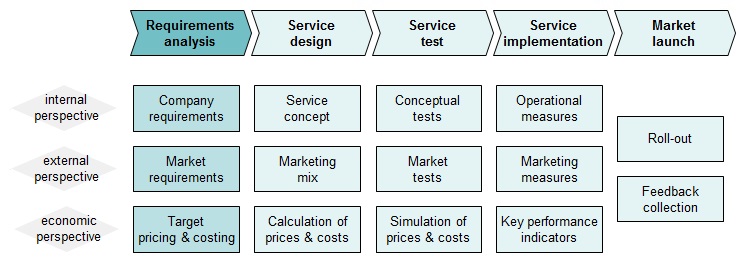
Figure: Activities within the requirements analysis phase
The requirements analysis phase should involve both external stakeholders (primarily existing and potential customers) and internal stakeholders (primarily the company’s own employees and management). This enables the company to identify customers’ needs and expectations in relation to the service right from the start, as well as any limitations on what can realistically be implemented in-house.
The requirements analysis typically follows the rough delivery process of the planned support services. That means asking which requirements and needs should be considered at each individual stage of the process. The diagram below shows part of the analysis process based on the example of airport repair shop services for motor vehicles, a business that involves offering services such as checks, inspections and repairs to customers who leave their car at the airport while they fly off on business or on vacation.

Figure: Identification of requirements (example)
One of the things to remember when making a list of requirements is to formulate them as clearly and unambiguously as possible, ideally using the verb ‘must’, as shown in the following examples:
- ‘The phone number of the repair shop must be easy to find in the phone book and on the internet.’
- ‘Incoming customer calls must be answered by the switchboard within two minutes.’
Assuming you wish to put the requirements to good use in the rest of the process, it is not enough to simply put them in a list. The key is to recognise that different requirements have different priorities, and it is therefore important to prioritise them using a method such as the following:
- Priority 1 (‘must have’):
Requirements that must be fulfilled in order to avoid major risks or disadvantages (e.g. of a legal or commercial nature, or significant damage to the company’s image). - Priority 2 (‘should have’):
Requirements that should be fulfilled because they have a major impact on the efficacy or efficiency of the service. - Priority 3 (‘nice to have’):
Requirements that have little or no impact on the efficacy or efficiency of the service. - Priority 4:
Unimportant requirements.
These priorities should be taken into account in the subsequent stages of the development process. For example, all the” Priority 1” requirements should definitely be included in the conceptual design and implementation of the new service.
Gathering the requirements typically involves the use of methods such as interviews, workshops or expert surveys. When interacting with customers it is particularly important to take the opportunity to discover what price they envisage for the service (‘What would customers be willing to pay for the new support service?’). Experienced employees with regular customer contact may also be able to provide some ballpark figures regarding prices. In addition, employees often have suggestions on how to avoid errors and non-conformities and how to optimise costs. All this information should be channelled into the task of getting a clear idea of commercially achievable prices and a rough cost structure for the support service by the end of the requirements analysis.
Correct analysis of support service requirements is a critically important factor in the service’s subsequent success. The key is to avoid mistakes such as the following:
- Requirements that are incomplete or too vague,
- Failure to put the detailed results of the requirements analysis in writing,
- Requirements that the developers cannot subsequently make sense of or that they misinterpret due to the inability of customers and employees to imagine how the service will subsequently be implemented,
- Attempts by developers to phrase requirements in their own words (which are often incomprehensible to customers and employees unless they have been explained),
- Failure by the developer to incorporate vital quality criteria that customers and employees did not list separately because they took them for granted, or attempts to add these quality criteria when it is already too late.
These kinds of errors often make it necessary to modify or expand support services after their implementation and launch, leading to significant extra costs and effort.
What are the key activities in the service design phase?
- Describe the services
- Model the processes
- Plan the resources
- Plan the marketing
- Calculate the prices and costs
Service design
Service design
When it comes to support services, the service design stage is often the most complex part of the process. As well as creating an overall concept for the service, it is also necessary to prepare ideas on how they will be marketed and make detailed calculations of the prices and costs.
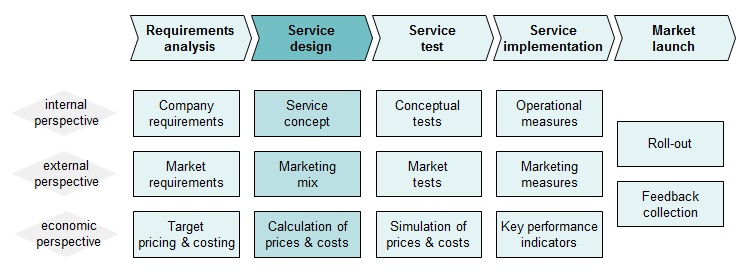
Figure: Activities within the service design phase
The service concept should describe first the outcome (i.e. what the service offers, or the ‘service description’), second the process (i.e. how the desired results of the service are brought about, or the ‘process description’), and, third, the required resources (i.e. what is needed to achieve this, or the ‘resource description’).
Service concept: description of the outcomes
Services are purchased to solve a problem faced by the customer. The customers expect the service to deliver this one result, or indeed multiple results, and to provide a benefit by solving their problem. The customer is primarily interested in the result – how this is brought about is generally of secondary importance in the customer’s mind. One of the most important parts of the development phase is therefore to describe outcome of the service to be delivered to the customer. This should comprise a written description that covers all the following aspects:
- Description of the benefit to the customer,
- Description of the core service,
- Description of any additional services,
- Description of possible variants (e.g. to cater to different customer groups),
- Definition of service levels (i.e. quality standards that must be met when delivering the service).
For companies that have a large portfolio of services, it makes sense to use the same structure for all their service descriptions. This makes it very easy to create a complete catalogue of services that gives customers a clear overview of exactly which services the company offers.
Remark: One way of dealing with more complex services is to divide them up into sub-services; ideally, these services should be designed in a modular format. This can be particularly beneficial in situations where support services are offered as an all-in package that is subsequently customised, i.e. by tailoring certain elements of the package to meet each customer’s individual needs.
Service concept: description of the processes
To achieve the desired service result it is generally necessary to run through a delivery process, typically involving both the service provider and the customer. After drawing up the service description to define what the results of the service are, the next step is to define the processes that describe how the service and the associated results will actually be brought about. This process description should therefore be prepared after completing the service description.
A number of commercial software tools are available to help create process descriptions. Various overviews and comparisons of the latest process modelling tools can be found in the relevant literature.
A useful modelling method worth mentioning in this context is ‘service blueprinting,’ which was developed specifically for describing service processes. A service blueprint provides a clear and detailed depiction of the processes involved in providing a service, with particular emphasis on picturing the service from the customer’s perspective. In its simplest form, the service blueprint may simply constitute a process consisting of individual activities that are carried out in sequence.
Service blueprinting makes an important distinction between customer actions and activities carried out by the company. However, as processes become more complex, it becomes harder to maintain a clear overview of which actions are assigned to customers and which to the company. It is therefore necessary to separate the sequence of actions into two different areas that are separated by a ‘line of visibility.’ This line separates the service delivery into onstage actions (which can be seen by customers) and backstage actions (which cannot be directly seen by customers).
As a rule, the description of the service delivery process should include everything from initial customer contact (e.g. a customer enquiry) to the very last service-related activity (e.g. billing, archiving). The diagram below demonstrates how this works using the example of airport repair shop services mentioned earlier:
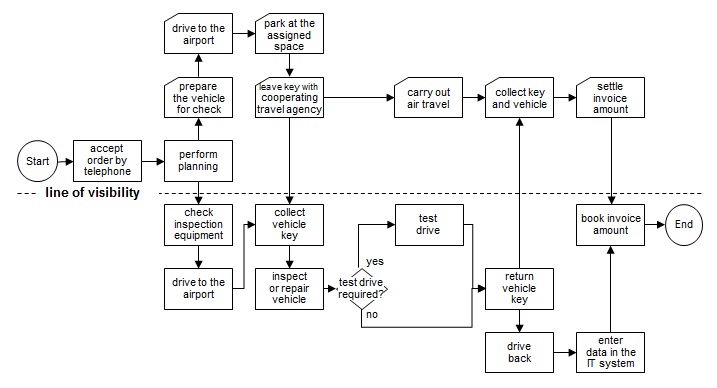
Figure: Service Blueprint (example)
Once the service blueprint has been created, the next step is to use this model to investigate how the process could potentially be optimised. The goal is to optimise the concept to the greatest possible degree before it reaches the implementation phase, rather than undertaking costly process improvements after the service has been launched. Practical experience has shown that this optimisation step should focus, in particular, on cutting back the following ‘time sinks’:
- Eliminating non-value creating processes,
- Reducing the number of interfaces,
- Reducing switches between different media,
- Reducing waiting times.
The process description should be designed to cover some 80 to 90 percent of cases in the service delivery process. The aim is to avoid creating overly complex process descriptions that cover even the most intricate, specialised cases, making them far too elaborate for the vast majority of cases.
Service concept: description of the resources
Once the process description has been created for a service, this can be used as a basis for drawing up a resource plan to list the resources required to deliver the service. This gives a clearer idea of which resources need to be deployed to subsequently deliver the service, particularly in terms of personnel and equipment.
Bearing in mind the key importance of ‘soft’ factors in service delivery, one of the key tasks in service development is to get a clear idea of how and where the various employees will be deployed. When developing a service it is, however, not advisable to directly link the tasks in a process to specific people, organisational positions or formal definitions of required qualifications: if a service is to be used by different organisational units, then it is important not to tie the description of the required resources to specific people or positions. Equally, providing a formal definition of required qualifications (e.g. MSc) is often not appropriate, since these are typically subject to country-specific variations and other differences that could make them unsuitable for general application in a service description.
The best way to avoid this problem is by using role concepts. A role concept describes the employee skills required to deliver the service in the form of roles. A role is defined by the experience, knowledge and abilities that are required for individual tasks. However, it says nothing about the person who will take on this role. A role is linked to skills and responsibilities. It can be assigned to multiple tasks and, equally, multiple roles may be assigned to one and the same task.
The allocation of roles to individual process steps can either be integrated into the process description that was created previously or presented in the form of a table.

Figure: Resource planning with role concepts
By avoiding directly linking specific individuals to specific tasks, role concepts create a very flexible planning tool. Skills and responsibilities can be defined from an early stage, and it becomes easier to assess qualification requirements and implement training and qualification programs. It also makes it easier to spot capacity bottlenecks earlier and take on new employees with plenty of time to spare.
In addition to human resources, a support service also requires material resources. The process of identifying, describing and planning the equipment and materials required is similar to that of creating role concepts. It generally proceeds as follows:
- Identify what equipment is required,
- Assign the equipment to individual process steps,
- Describe the equipment,
- Determine the overall equipment requirements for subsequent delivery of the service.
Once again, the allocation of equipment and materials to individual process steps can either be integrated into a process description or presented in the form of a table.
Marketing mix
In parallel to the service concept consisting of descriptions of the outcomes, processes and resources, it is also necessary to develop a marketing concept. Above all, this means defining a marketing strategy and planning what is known as the marketing mix. The process of developing the marketing strategy should include defining target groups, positioning the new service within the overall portfolio of services, and clarifying internal responsibilities for the marketing activities. The subsequent marketing mix stage includes a definition of all the operational activities and instruments required to support the marketing of the new service.
It is advisable to focus on the ‘four Ps’ of product, price, place, and promotion when designing a marketing mix. These are broken down as follows:
- Product:
Scope of performance, unique selling points, cross-selling potential, branding. - Price:
Price level, differential pricing (e.g. by location, time, quantity, special reduced rates), price bundling, cross-selling prices, terms and conditions of delivery and payment. - Place:
Distribution sites, distribution channels, sales partners, delivery capacity, delivery benefits. - Promotion:
Advertising strategy, advertising media (exhibitions, journals, internet, etc.), promotional materials (brochures, direct mail, events, etc.), internal communication.
- Building up and exploiting referrals,
- Developing customer acquisition and customer retention strategies,
- Bundling together related sales, and
- Introducing an active complaints management process.
The key challenge at this stage is to tailor all these activities to the new service in a way that leads to the best possible overall effect.
Calculation of prices and costs
As well as designing the service and defining the marketing mix, the service design phase also involves calculating the prices and costs of the new support service in detail.
A template developed in the T-REX project can be used for this purpose. It includes typical cost items for the development of the support service as well as examples of the fixed costs and variable costs involved in delivering the support service. If the decision is taken to include a risk analysis, it is generally a good idea to calculate figures not only for the most probable or ‘normal’ case, but also for the best case and worst case scenarios.
Another key part of this phase is to determine the effects that the new or redesigned support service will have on the product business.
The final result of the service design phase should be a clearly formulated support service concept that provides detailed operational plans to supplement the more strategic considerations contained in the business model.
What are the key activities in the service design phase?
- Describe the services
- Model the processes
- Plan the resources
- Plan the marketing
- Calculate the prices and costs
Service test
Service test
The aim of this phase is to use a series of tests to perform a final check of the new service before it is implemented and launched and to make any necessary adjustments. Tests can be carried out only on a service strategy that is largely complete, i.e. one that already has clearly defined value propositions, processes and resources.
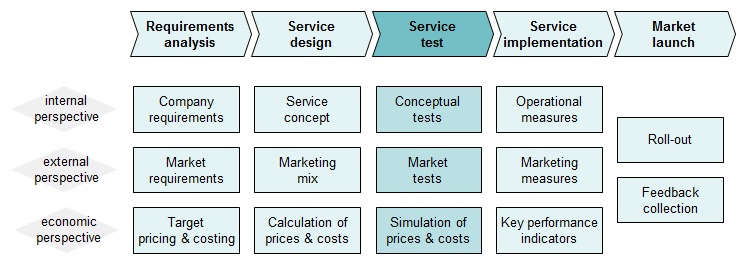
Figure: Activities within the service test phase
Although services are generally harder to test than material goods and software, the following suggestions are worth considering:
- Acceptance test:
Check in-house acceptance levels: will the new service be accepted by employees? Does the new service fit into the employees’ current incentive system? Are the proposed marketing and training activities sufficient? - Usability test:
Check equipment and materials: does the equipment meet the necessary ergonomic requirements? Are employees comfortable with the equipment that is already in use? - User test:
Real-life test and/or restricted launch: is the new service accepted by customers? Is the price right? Does the way the service is delivered match the organisational and personnel requirements? - Price and cost simulation:
Create a simulation model based on the previously defined process descriptions and record each individual activity together with its cost data: what critical factors does the simulation reveal (e.g. bottlenecks)? Where are the profitability thresholds? Which steps in the process must be monitored particularly carefully in the future?
The figure below shows an example of a cost simulation based on a designed delivery processes. The basic idea is to put the process description (e.g. a service blueprint) into a professional process modelling and simulation software. Then, each process step (‘activity’) is added by cost information and finally the simulations could be run. The advantage is, that developers (and controllers) could ‘play” with different cost assumptions and analyse how cost-sensitive the service concept is.
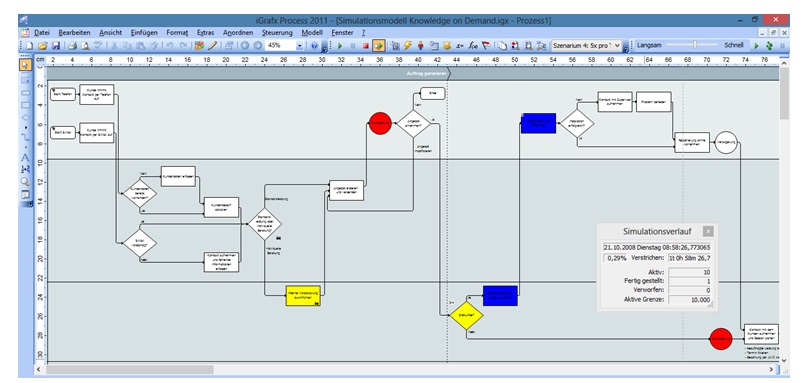
Figure: Cost simulation based on a process model
The test results can be used as a basis for making final adjustments. These adjustments can, in principle, be made to any part of the service concept.
What are the key activities in the service test phase?
- Test the service as thoroughly as possible
- Get stakeholders involved
- Make adjustments as necessary
Service implementation
Service implementation
Much of the work described so far will have taken place within a project team, but the service implementation phase generally has a direct impact on many other areas of the company, too. In particular, it is generally necessary to carry out a series of organisational and personnel-related activities to prepare the company to deliver the service.
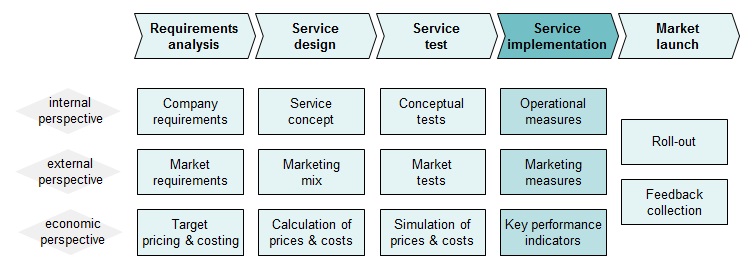
Figure: Activities within the service implementation phase
The first step should be to create internal documentation of the support service on the basis of the service description. This will primarily be used as an aid for those who are subsequently responsible for the service and for the employees who actually deliver the service. The documentation should provide information on all the key components of the service, because employees will be unable to explain and communicate the service to customers effectively if they are not properly briefed. In addition to a concise introductory description and a presentation of the customer benefits linked to the service, the documentation usually includes a description of the results and features. In addition, it typically provides an overview of the processes associated with the service and includes a list of the required resources. Generally speaking, further activities will still be necessary in regard to creating the required forms (practical experience has shown that forms are often the key ‘carrier’ of a service) and linking service to the company’s existing ICT systems (e.g. integrating the new service in sales information systems and order processing systems).
The process description created in the design phase serves as a starting point for taking organisational steps within the company, primarily in relation to how the new service process will be implemented in-house. As well as defining who will be responsible for supervising and delivering the new service, it is also necessary to clarify the interfaces between the new service and other services and company-wide processes such as billing and archiving. Depending on the objectives and scope of the new service, the implementation phase may also involve measures to expand the organisation, for example by setting up new organisational units.
The resource plans provide a good starting point for personnel measures. These generally include the following:
- Recruiting new employees if the existing workforce is not sufficient to deliver the new service,
- Preparing and conducting training and qualification activities (e.g. creating training materials to build up required skills),
- Developing incentives to deliver the new service and dovetailing these with the existing incentive system.
In addition to the personnel measures, another key point in the implementation phase is to deal with the equipment requirements. Based on the resource description, the required materials and equipment must be acquired and made available for use.
Implementation of the marketing activities is also very much based on the plans that have already been made. These activities vary tremendously and are largely dependent on the type of service being launched. Examples of possible marketing activities that may be performed in the implementation phase include the following:
- Typesetting, layout and printing of brochures and catalogues of services,
- Preparing advertisements in magazines and specialist journals,
- Preparing information events such as exhibitions and trade fairs,
- Creating websites,
- Finding sales and distribution partners,
- Establishing contact with key disseminators and opinion leaders (e.g. the media, associations),
- Preparing internal communication activities.
What are the key activities in the service implementation phase?
- Design the organisational structure
- Prepare the employees
- Acquire the equipment and materials
- Start the marketing activities
- Select the key performance indicators
Market launch
Market launch
Once the new service has been implemented, the next step is to launch it. That means organising the costly and time-consuming step of rolling out the new service and carefully monitoring the start-up phase. One of the most important parts of this monitoring is to systematically acquire feedback from all the different stakeholders.
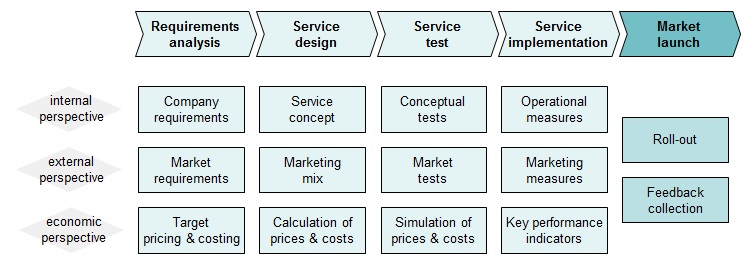
Figure: Activities within the market launch phase
Roll-out
The term ‘roll-out’ refers to the initial phase of delivering a new service. Having already been developed and tested, the service is now prepared for the marketplace. A roll-out generally proceeds as follows:
- Decide on the launch strategy (e.g. pilot launch),
- Decide when to launch the service,
- Carry out internal and external communication activities,
- Carry out internal and external information sharing,
- Make the equipment and materials available to the employees concerned,
- Set up a hotline for customers and employees,
- Prepare a launch package for the relevant employees (e.g. including descriptions of the service and processes, forms, brochures, instruction manuals, details of contact partners).
Feedback collection
Once the roll-out has been completed, the new service can be made freely available to customers. This effectively marks the end of the development process. It is nevertheless a good idea to continue keeping close tabs on the service, especially in the period immediately after its launch, in order to monitor the initial stages and get feedback from customers and employees. Key activities at this stage include the following:
- Business controlling:
Define key indicators of success and quality before the launch (e.g. revenue, quantities, lead times, complaints) and record and analyse these indicators. - Market feedback:
Evaluate requests and queries, analyse complaints, carry out and evaluate direct interviews with customers and, if relevant, carry out and evaluate a customer survey. - Employee feedback:
Evaluate requests, evaluate employee complaints, carry out and evaluate direct interviews with employees and, if relevant, carry out and evaluate an employee satisfaction survey.
What are the key activities in the market launch phase?
- Organise the roll-out
- Monitor the initial period after launch
- Make adjustments as necessary
 Fraunhofer IAO | Service and Human Resources Management
Fraunhofer IAO | Service and Human Resources Management